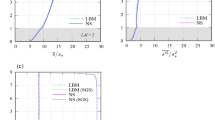Abstract
The problem of modeling scalar variance from an elevated source is discussed at length. From a simple model, it is shown that observed behavior is entirely a result of the growth of the instantaneous plume width relative to the mean plume width. From a model valid for large sources, we suggest a simple explanation for the apparent dependence of asymptotic levels of variance on source size. Pope (1983) has pointed out that second order models of passive scalar transport do not retain the superposability of the primitive equations. Explanations for this, and possible consequences are explored. It is shown how second order models for the rapid terms, the time scales of which are determined by the mean velocity (rather than inertial spectral transfer), can be constructed in a superposable manner (Shih, 1984). Difficulties are described in simultaneously satisfying requirements imposed on the cross-dissipation by realizability and by superposability. We present computations of the data of Warhaft (1984) using a model in which the transport is based on first principles, and much of the rest of the model satisfies realizability. The model is able to reproduce the data of Warhaft satisfactorily if the initial plume width is larger than the Kolmogorov microscale. Calculations are carried out of a plume superposed on a background; satisfactory results are achieved when the background level is low, despite the lack of formal superposability, leading to the conclusion that this may not be a serious problem.
Access this chapter
Tax calculation will be finalised at checkout
Purchases are for personal use only
Preview
Unable to display preview. Download preview PDF.
Similar content being viewed by others
References
Chatwin, P. C. & Sullivan, P. J. 1979. The relative diffusion of a cloud of passive contaminant in incompressible turbulent flow. J. Fluid Mech. 91: 337–355.
Chen, J.-Y. & Lumley, J. L. 1984. Second order modeling of the effect of intermittency on scalar mixing. Proceedings, 20th International Symposium on Combustion. In Press.
Comte-Bellot, G. & Corrsin, S. 1966. The use of a contraction to improve the isotropy of grid-generated turbulence. J. Fluid Mech. 25: 657–682.
Csanady, G. T. 1967a. Concentration fluctuations in turbulent diffusion. J. Atmos. Sci. 24: 21–28.
Csanady, G. T. 1967b. Variance of local concentration fluctuations. Physics of Fluids Supplement: S76–S78.
Dancey, C. 1984. The Effect of Intermittency on Scalar Mixing. Ph. D. Thesis. Ithaca, NY: Cornell.
Durbin, P. A. 1980. A stochastic model of two-particle dispersion and concentration fluctuations in homogeneous turbulence. J. Fluid Mech. 100: 279–302.
Fackrell, J. E. & Robins, A. G. 1982. Concentration fluctuations and fluxes in plumes from point sources in a turbulent boundary layer. J. Fluid Mech. 117: 1–26.
LaRue, J. C., Libby, P. A. & Seshadri, D. V. R. 1981. Further results on thermal mixing layer downstream of a turbulence grid. In Third Symposium on Turbulent Shear Flows, ed. L. J. S. Bradbury et al, pp. 15.1–15.6. Davis: U. of California.
Lumley, J. L. 1978. Computational modeling of turbulent flows. In Advances in Applied Mechanics 18, ed. C.-S. Yih, pp 123–176. New York: Academic.
Lumley, J. L. 1983a. Turbulence modeling. J. Applied Mech. 50: 1097–1103.
Lumley, J. L. 1983b. Atmospheric Modeling. The Institution of Engineers, Australia: Mechanical Engineering Transactions. ME 8: 153–159.
Lumley, J. L. & Mansfield, P. 1984. Second order modeling of turbulent transport in the surface mixed layer. Boundary Layer Meteorology. In Press.
Lumley, J. L. & Newman, G. R. 1977. The return to isotropy of homogeneous turbulence. J. Fluid Mech. 84: 581–597.
Orszag, S. A. 1970. Analytical theories of turbulence. J. Fluid Mech. 41: 363.
Pope, S. B. 1983. Consistent modeling of scalars in turbulent flows. Physics of Fluids, 26: 404–408.
Shih, T.-H. 1984. Second Order Modeling of Scalar Turbulent Flow. Ph. D. Thesis. Ithaca NY: Cornell.
Shih, T.-H. & Lumley, J. L. 1982. Modeling heat flux in a thermal mixing layer. In Refined Modeling of Flows, Vol. I (eds. J. P. Benqué et al). Paris: Presses Ponts et Chaussées, pp. 239–250.
Warhaft, Z. 1984. The interference of thermal fields from line sources in grid turbulence. J. Fluid Mech. 144: 363–387.
Author information
Authors and Affiliations
Editor information
Editors and Affiliations
Rights and permissions
Copyright information
© 1985 Springer-Verlag Berlin Heidelberg
About this paper
Cite this paper
Lumley, J.L., Van Cruyningen, I. (1985). Limitations of Second Order Modeling of Passive Scalar Diffusion. In: Davis, S.H., Lumley, J.L. (eds) Frontiers in Fluid Mechanics. Springer, Berlin, Heidelberg. https://doi.org/10.1007/978-3-642-46543-7_11
Download citation
DOI: https://doi.org/10.1007/978-3-642-46543-7_11
Publisher Name: Springer, Berlin, Heidelberg
Print ISBN: 978-3-642-46545-1
Online ISBN: 978-3-642-46543-7
eBook Packages: Springer Book Archive




